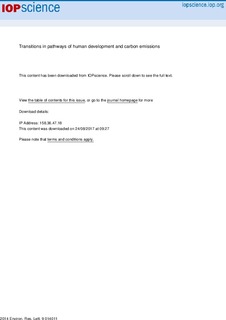Transitions in pathways of human development and carbon emissions
Peer reviewed, Journal article
Published version
Permanent lenke
http://hdl.handle.net/11250/2465272Utgivelsesdato
2014Metadata
Vis full innførselSamlinger
- Journal articles [478]
Originalversjon
10.1088/1748-9326/9/1/014011Sammendrag
Countries are known to follow diverse pathways of life expectancy and carbon emissions, but little is known about factors driving these dynamics. In this letter we estimate the cross-sectional economic, demographic and geographic drivers of consumption-based carbon emissions. Using clustering techniques, countries are grouped according to their drivers, and analysed with respect to a criteria of one tonne of carbon emissions per capita and a life expectancy over 70 years (Goldemberg's Corner). Five clusters of countries are identified with distinct drivers and highly differentiated outcomes of life expectancy and carbon emissions. Representatives from four clusters intersect within Goldemberg's Corner, suggesting diverse combinations of drivers may still lead to sustainable outcomes, presenting many countries with an opportunity to follow a pathway towards low-carbon human development. By contrast, within Goldemberg's Corner, there are no countries from the core, wealthy consuming nations. These results reaffirm the need to address economic inequalities within international agreements for climate mitigation, but acknowledge plausible and accessible examples of low-carbon human development for countries that share similar underlying drivers of carbon emissions. In addition, we note differences in drivers between models of territorial and consumption-based carbon emissions, and discuss interesting exceptions to the drivers-based cluster analysis.
